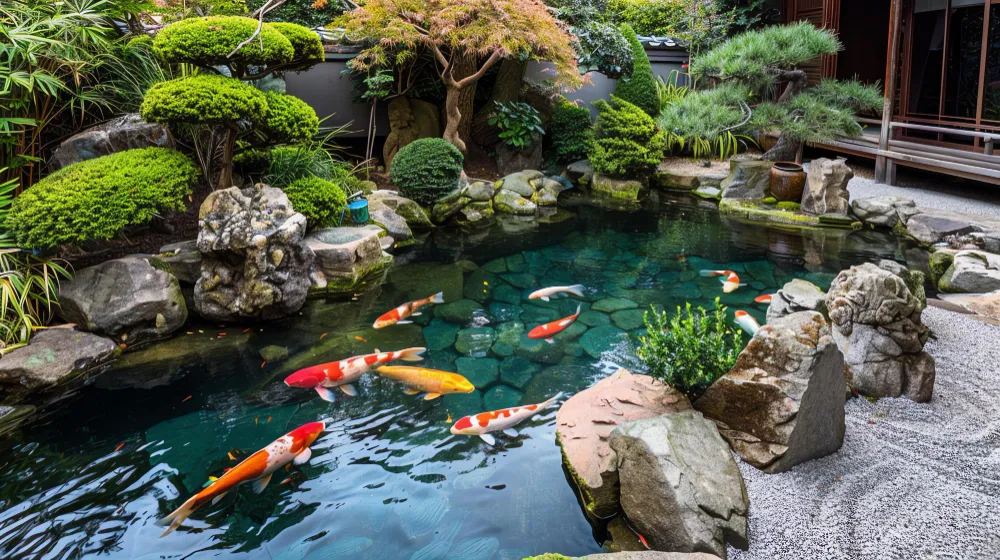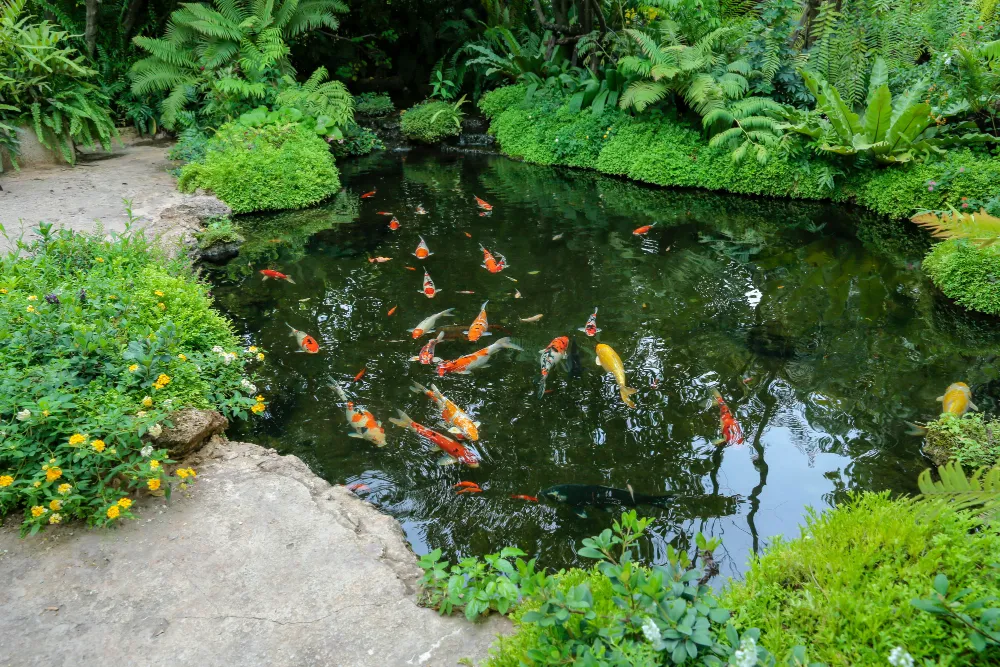
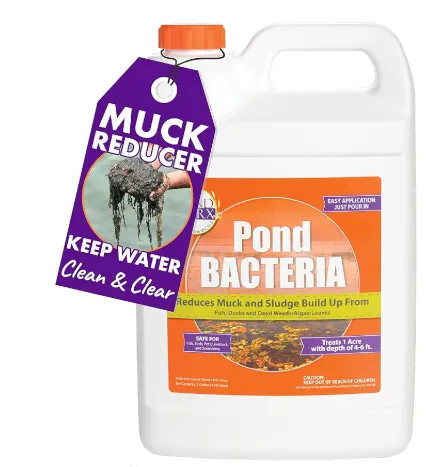
Koi Pond Ideas: Transform Your Outdoor Space with Creative Koi Pond Ideas
Creating a koi pond can serve not only as a beautiful focal point in your outdoor space but also as a serene retreat where you can connect with nature. Koi ponds are popular among garden enthusiasts and pet owners alike, as they provide a habitat for koi fish while enhancing the aesthetic appeal of your landscape. In this article, we will discuss various aspects of koi pond creation including design tips, water quality maintenance, and landscaping ideas that will inspire you to create your perfect outdoor oasis.
Explore innovative koi pond ideas that blend beauty and functionality, creating a welcoming environment for both koi and visitors. These koi pond ideas can enhance your garden and provide tranquility.
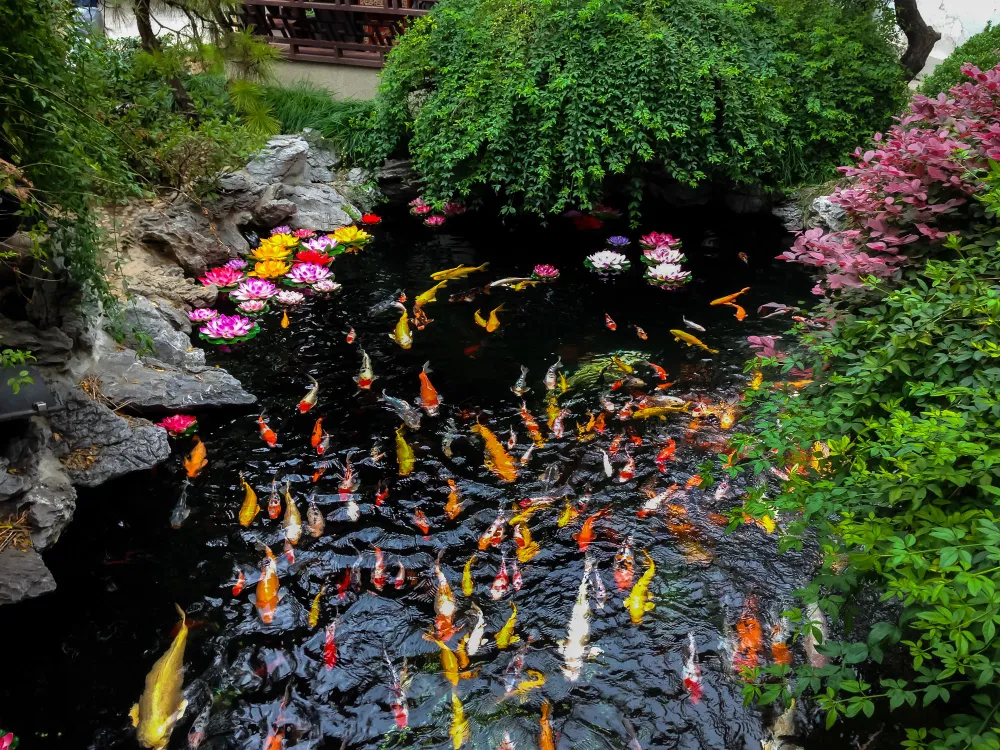
Koi Pond Design Tips
Choose the Right Location
The location of your koi pond is one of the most critical decisions you’ll make. Ideally, it should be situated in an area that receives a balance of sunlight and shade. Koi fish thrive in sunlight but need shaded areas to escape the heat during warmer months. Choose a location that is relatively flat to avoid complications with water runoff and erosion.
Avoid placing your pond too close to large trees since falling leaves can create debris in the pond and affect water quality. Additionally, consider the proximity to your home for easy access and maintenance. An elevated viewpoint can serve as a perfect vantage point for viewing your koi, so factor in the visibility from your home or patio.
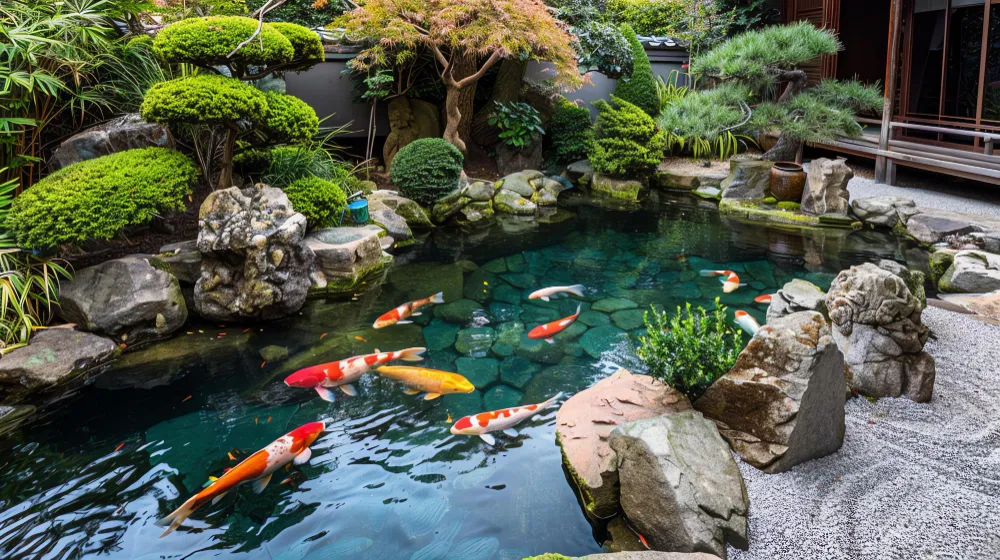
Choosing koi pond ideas that suit your landscape can elevate your outdoor experience. These koi pond ideas can range from simple designs to elaborate water features.
Consider various koi pond ideas that involve incorporating natural elements to create a more organic look. These koi pond ideas help ensure your fish thrive.
Determine the Size and Depth
When planning the size of your koi pond, consider the number of koi you plan to keep. A general rule of thumb is to provide at least 250 gallons of water per koi fish to ensure they have ample space to grow and thrive. The depth of the pond is also essential, as koi can grow quite large, averaging between 12 to 36 inches depending on the breed. A depth of at least 3 feet is recommended to allow for comfortable wintering in colder climates.
When implementing koi pond ideas, remember that the integration of elements like plants and rocks can enhance the aesthetic and health of your pond.
Map out your design on paper and consider creating zones in the pond for different activities, such as swimming or spawning. A larger pond allows for better water quality and provides a more natural environment for the koi, encouraging their natural behaviors.
Incorporate Natural Elements
Among the many koi pond ideas, ensuring good filtration can dramatically improve the water quality and overall health of the koi.
Natural elements such as rocks, logs, and plants can enhance the beauty and functionality of your koi pond. Using large rocks around the edges or at the bottom can create hiding spots for koi, reducing stress levels and providing a more natural habitat. Additionally, incorporating water features like waterfalls or streams can help with aeration and create soothing sounds that enhance relaxation.
Consider adding aquatic plants that can thrive in your pond’s environment. Marginal plants like cattails and water lilies not only beautify the space but also provide shade and shelter for the fish. These plants can help keep algae in check, providing a natural balance in the ecosystem.
Select Suitable Materials
Regular testing is a key part of koi pond ideas that promote optimal water quality, ensuring a healthy environment for koi fish.
Choosing the right materials for your koi pond is vital for durability and safety. Pond liners, which can be made from rubber or flexible PVC, are essential for retaining water. Be sure to select a high-quality, non-toxic liner to ensure the health of your koi. Surrounding the pond with natural stones or concrete can create a solid perimeter that not only looks good but also prevents erosion.
Consider incorporating a filtration system that is suitable for the size of your pond. A good filtration system will help maintain water clarity and quality, ensuring the health of your koi. Research different types of filters—mechanical, biological, and UV filters—to find the best combination for your specific needs.
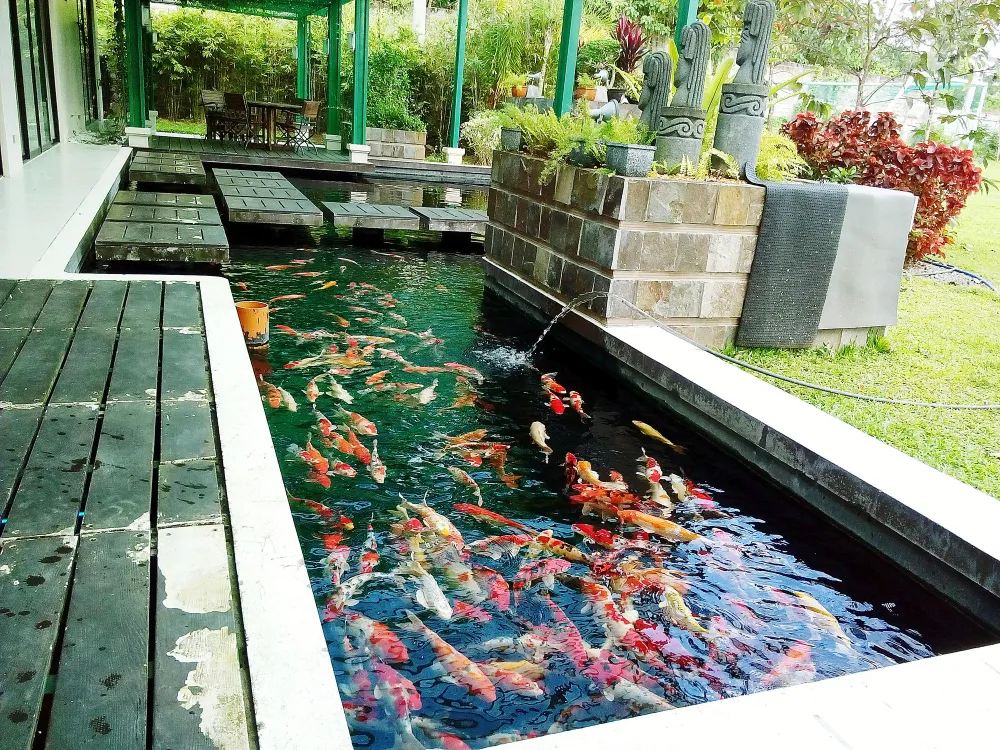
Water Quality Maintenance
Understanding Water Chemistry
Maintaining optimal water quality is crucial for the health of your koi fish. Key parameters to monitor include pH, ammonia, nitrites, and nitrates. The ideal pH range for koi is between 7.0 and 8.5. Regular testing using water quality kits can help you keep track of these parameters and prevent any detrimental changes in the pond environment.
Ammonia and nitrites should be kept at zero, as they are toxic to koi. Nitrates should be kept below 40 ppm. If levels surge, consider performing partial water changes and checking your filtration system for effectiveness. It’s essential to maintain a balance in water chemistry to create a healthy habitat for your koi.
Implementing Filtration Systems
Adapting your maintenance strategies based on seasonal changes is one of the best koi pond ideas for ensuring your pond remains vibrant throughout the year.
A quality filtration system is a linchpin in maintaining a koi pond. There are three main types of filtration systems: mechanical, biological, and ultraviolet (UV) filters. Mechanical filters remove debris and particulates from the water, while biological filters support beneficial bacteria that break down harmful waste products. UV filters use ultraviolet light to kill algae and pathogens, helping to keep water clear and healthy.
When designing your koi pond, factor in the filtration system’s location and accessibility for maintenance. Ensure that the pump capacity is adequate for the volume of water in your pond. Aim for a system that cycles the entire pond volume at least once every hour to maintain optimal water quality.
Regular Testing and Monitoring
When considering koi pond ideas, think about the types of plants that will thrive in your koi pond, as they play a crucial role in the ecosystem.
Regular testing and monitoring of your pond’s water quality are essential practices for koi care. Create a schedule for testing water parameters, ideally once a week during the warmer months and bi-weekly in colder months. Use reliable test kits to monitor pH levels, ammonia, nitrites, and nitrates. Taking proactive measures to maintain water quality can prevent many health issues in koi.
In addition to water tests, keep an eye on the physical appearance of your koi. Look for signs of distress, such as erratic swimming patterns, loss of appetite, or abnormal coloring. These signs can indicate water quality issues or potential diseases, which require immediate attention.
Your koi pond ideas should also include creating natural habitats that mimic natural environments, fostering the well-being of your koi.
Seasonal Maintenance Tips
Seasonal changes bring different challenges to koi pond maintenance. During the spring, focus on cleaning the pond and removing debris accumulated over the winter. It’s also the ideal time to inspect your filtration system and make any necessary repairs. Ensure your plants are healthy and consider reintroducing beneficial bacteria to kickstart the biological filtration process.
Summer maintenance involves regular water testing and monitoring of algae growth. If algae blooms occur, consider treatments or additional filtration to keep the water clear. In the fall, prepare your pond for winter by gradually reducing feeding and cleaning up fallen leaves to avoid contamination. As temperatures drop, ensure your koi have enough depth to survive the winter months, and consider using a pond heater to keep a small area of water unfrozen.
Enhance your koi pond with thoughtful koi pond ideas that add decorative features, making your pond a stunning visual focal point.
Landscaping Around the Pond
Choosing the Right Plants
Lighting options are among the most impactful koi pond ideas that will allow you to enjoy your pond even at night.
Incorporating vegetation around your koi pond can create a beautiful, natural aesthetic and help with water quality. Choose native plants that thrive in your region and that can tolerate aquatic environments. Water lilies, lotus, and submerged plants are excellent choices that contribute to oxygenation and provide shade for the koi.
Utilizing the insights from FAQs about koi pond ideas can help you optimize your pond’s design and maintenance effectively.
Consider planting hardy perennials and shrubs around the pond to create a landscaped feel. These plants not only provide an appealing visual element but can also help in controlling erosion and providing necessary shade. Be mindful to avoid toxic plants that could harm your koi, such as certain ornamental species.
Creating a Natural Habitat
Designing a space that mimics a natural aquatic habitat encourages healthy koi behavior and enhances the pond’s ecosystem. Incorporate rocks, logs, and natural materials to create varying depths and hiding spots within the pond. This variability can provide koi with places to retreat and feel safe, which is especially important during spawning season.
Additions like gravel beds can also help beneficial bacteria thrive, aiding in the natural filtration process. A mix of open swimming areas and sheltered zones will create a balanced environment for your koi, encouraging them to stay active and healthy.
Adding Decorative Features
Incorporating these koi pond ideas will ensure the longevity and beauty of your koi pond, making it a cherished part of your outdoor space.
Embrace innovative koi pond ideas that enhance both your property and the lives of your koi, creating a harmonious outdoor environment.
Utilizing effective koi pond ideas can help you create a sanctuary that incorporates both aesthetics and ecology for your koi.
Decorative features can elevate the aesthetic appeal of your koi pond significantly. Consider adding features like waterfalls, fountains, or bridges. Waterfalls not only enhance the beauty of the pond but also help aerate the water, benefiting the koi. Fountains can serve as both decorative and functional elements, providing continuous water movement and oxygenation.
Consider adding benches or seating areas around the pond to create a welcoming atmosphere for relaxation and enjoyment. Decorative stones, statues, or even a gazebo can further enhance the visual appeal of the space, making it a delightful area for gatherings or quiet reflection.
Lighting Options for Nighttime Viewing
Lighting can transform your koi pond into a magical nighttime oasis, allowing you to enjoy its beauty even after the sun sets. Submersible LED lights can illuminate the pond, showcasing your koi and aquatic plants. Place lights strategically to highlight waterfalls, plants, and the pond’s edges for a captivating nighttime effect.
In addition to underwater lights, consider incorporating pathway or deck lights to enhance safety and create an inviting atmosphere around the pond. Solar-powered lights are energy-efficient and easy to install, offering a sustainable option for nighttime illumination.
FAQs about Koi Ponds
1. How deep should a koi pond be?
The minimum depth for a koi pond should be at least 3 feet to provide a suitable environment for koi, especially in colder climates where they need to winter.
2. What size pond do I need for koi?
As a rule of thumb, provide around 250 gallons of water per koi fish to ensure they have adequate space for growth.
3. How often should I test the water quality?
Water quality should be tested at least once a week during the warmer months and bi-weekly in winter to ensure optimal conditions for your koi.
4. Can I keep plants in my koi pond?
Yes, incorporating aquatic plants like water lilies and submerged plants can improve water quality and provide shade and shelter for your koi.
5. What should I do during winter with my koi pond?
During winter, ensure the pond has adequate depth to prevent freezing, and consider using a pond heater to keep a small area of water unfrozen. Reduce feeding as koi become less active.
Conclusion
Creating a koi pond can transform your outdoor space into a serene and beautiful environment that brings joy and relaxation. From careful planning in design and location to maintaining water quality and incorporating natural elements, each step contributes to the overall health and beauty of your pond. Regular maintenance and thoughtful landscaping will ensure that your koi thrive and that your pond remains a stunning focal point in your garden.
Understanding the essential aspects of koi pond creation and maintenance allows you to develop a space that not only enhances your property but also provides a nurturing environment for these beautiful fish. Embrace the opportunity to connect with nature and create your own outdoor sanctuary that can be enjoyed for years to come.
You may also like
- https://giobelkoicenter.com/what-do-koi-fish-represent-symbolism/
- https://giobelkoicenter.com/feminine-small-koi-fish-tattoo/
- https://giobelkoicenter.com/koi-variety-discovering-30-koi-fish-varieties/
- https://giobelkoicenter.com/9-koi-fish-feng-shui/
- https://giobelkoicenter.com/lucky-number-of-koi-fish-in-a-pond/
Table of Contents
Passionate about fish keeping since elementary school in the 1980s, Giovanni Carlo has dedicated countless hours to collecting and breeding a diverse array of ornamental freshwater fish. From vibrant guppies and majestic koi to striking bettas and classic goldfish, he continues to explore the fascinating world of aquatics, sharing knowledge and enthusiasm with fellow fish enthusiasts.
